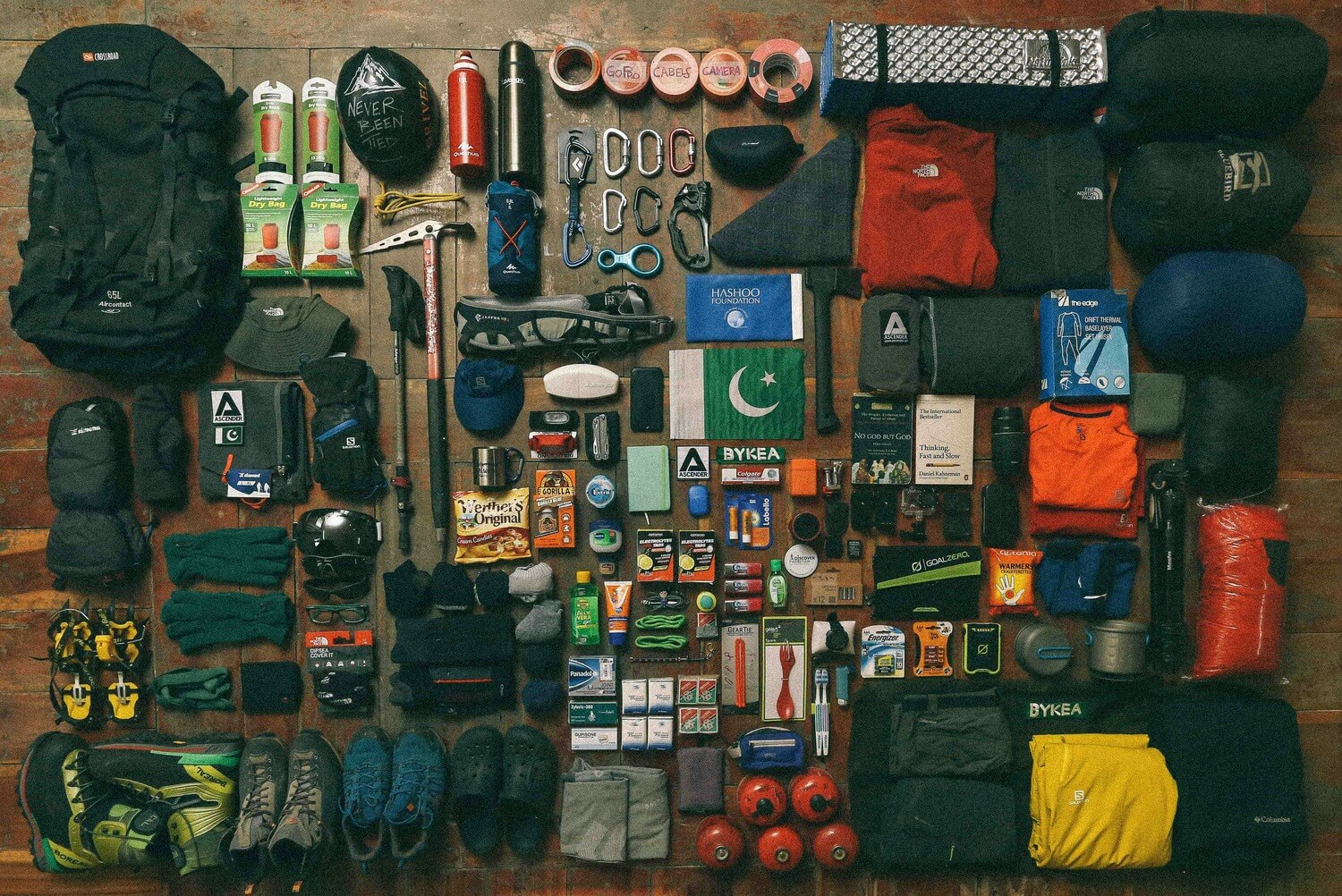Planning to escape into nature? This comprehensive camping checklist ensures you’ll have everything necessary for a successful outdoor experience. Whether you’re a seasoned outdoor enthusiast or a first-time camper, use this guide as your foundation for a well-prepared adventure.
Comprehensive Camping Checklist
This extensive list covers various camping styles and preferences. For minimalists who prefer traditional camping approaches, you may not need every item listed. The most important consideration is ensuring you have the essentials for your basic needs: hydration, nourishment, shelter, and warmth.
From there, customize your gear based on personal preference and experience.
1. Food Prep
☐ Kitchen knife
☐ Water containers
☐ Insulated cooler or refridgerator
☐ Camp cookware set
☐ Cups
☐ Multi-purpose opener
☐ Travel cutting board
☐ Portable washing station for dishes
☐ Plates & bowls
☐ Travel coffee/tea brewing system
☐ Portable stove with fuel
☐ Eating utensils
2. Personal Care
☐ Sanitary paper
☐ Personal hygiene products
☐ Cleansing wipes
☐ Microfiber towel
☐ Antibacterial gel
☐ Portable waste system (you have many options here)
☐ Basic toiletries
3. Fire Starting
☐ Compact saw
☐ Fire starter material
☐ Firewood (where permitted)
☐ Wood splitting tool
4. Light & Power
☐ Portable charger (solar option if available)
☐ Camp lantern
☐ Backup batteries
☐ Headlamp with spare batteries/charging equipment
5. Misc. Essentials
☐ Insect repellent
☐ Lip balm
☐ Sunscreen
6. Shelter & Sleep
☐ Hammock
☐ Travel pillow for camping
☐ Shade structure/tarp (if needed)
☐ Outdoor blanket
☐ Sleeping pad/camping mat
☐ Tent with additional stakes
☐ Sleeping bag with liner
7. Recreation
☐ Audio books
☐ Outdoor activities and games
☐ Devices for entertainment (for bad weather)
☐ Journal
☐ Reading material
☐ Astronomy guides
8. Clothing
☐ Sun hat
☐ Gloves
☐ Trail shoes
☐ Sunglasses
☐ Moisture-wicking socks
☐ Waterproof outerwear
☐ Thermal under-layers
☐ Insulated headwear
☐ Convertible pants/shorts
☐ Mid-layer fleece
☐ Bathing attire
☐ Nighttime clothing
☐ Insulated jacket
☐ Quick-dry undergarments & shirts
9. Site Maintenance
☐ Trash bags
☐ Absorbent cloths
☐ Eco-friendly cleaning products
10. Pet Necessities
☐ Pet food storage containers (sealed)
☐ Medications
☐ Portable water dish
☐ Comfort items
☐ Pet emergency supplies
☐ Poop bags
☐ Collar and leash
11. Camp Setup & Tools
☐ Multi-purpose tool
☐ Folding camp table
☐ Heavy-duty tape
☐ Waterproof storage containers
☐ Mallet/hammer for tent stakes
☐ Utility cord/rope
☐ Camping chairs
12. Safety
☐ Wildlife identification guides
☐ Medications
☐ Bear spray (where needed)
☐ Site reservation confirmation
☐ Navigation tools
☐ Required permits/passes
☐ Binoculars
☐ Water filtration
☐ First-aid kit
Tips For Using This Checklist

Not every item will be necessary for every excursion—your specific requirements will depend on your destination, duration, and activities. Keep this list accessible on your mobile device or print a physical copy to reference while packing.
Camping Approaches
Your camping style significantly impacts what gear you’ll need and how you’ll pack. Consider which of these approaches best matches your outdoor adventure plans.
Vehicle-Accessible Camping: When your vehicle is parked adjacent to your site, you can afford to bring comfort-enhancing items. Space and weight constraints are minimal, allowing for a more luxurious outdoor experience.
Wilderness Backpacking: When every item must be carried, weight becomes critical. Focus on lightweight, multipurpose equipment and carefully evaluate necessity versus convenience for each item.
Luxury Camping: For established glamping locations, many amenities may be provided. Verify what’s included with your accommodation provider and supplement with personal items as needed.
Recreational Vehicle Camping: Your mobile accommodation likely includes many built-in essentials. Concentrate on consumable supplies, system maintenance, and supplementary equipment. Consider developing a separate RV-specific inventory for these specialized needs.
Seasonal Considerations
The time of year you camp will dramatically affect your packing needs and preparation. Each season offers unique experiences but requires specific gear adjustments.
Spring Expeditions: Additional weather protection and layering options are essential as conditions can be unpredictable. Prepare for potential mud and varied temperatures.
Summer Adventures: Prioritize heat management and hydration. Always pack more water than anticipated for warm weather camping.
Autumn Outings: Versatile clothing layers and weather-resistant gear are crucial. Enhanced lighting becomes important with earlier sunsets.
Winter Excursions: Emphasize thermal insulation with supplementary sleeping protection and specialized cold-weather gear. Winter camping requires advanced preparation for extreme conditions.
Beginner Recommendations
If you’re new to outdoor recreation, consider these additional preparation steps beyond simply gathering equipment.
Equipment Testing
Don’t wait until arrival to familiarize yourself with your equipment. Assemble your shelter at home before departure. Ensure all components are present and practice assembly and disassembly several times. This preparation will prove invaluable when setting up in less-than-ideal conditions or limited daylight.
Cooking Systems
Your portable cooking equipment will be essential for meal preparation and morning beverages. Practice connecting fuel sources, adjusting heat settings, and preparing a simple meal. Understand the differences from home cooking equipment and identify any operational quirks. Test any fuel-powered lighting or heating equipment similarly.
Weather
Review both extended and immediate weather forecasts for your destination. Research typical climate patterns for your planned dates and location.
Remember that temperature variations between day and night can be substantial, particularly in mountainous regions. Pack appropriate clothing and equipment for conditions approximately 10-20 degrees beyond predicted temperatures in both directions.
Rules
Each camping area maintains specific regulations. Research quiet hours, fire restrictions, wildlife considerations (including food storage requirements), and pet policies if traveling with animals.
Trip Plan Communication
Always inform a reliable contact of your itinerary. Provide specific location details, anticipated arrival and departure times, traveling companions, and vehicle information. Establish check-in expectations and emergency response timeframes. Provide ranger station contact information if applicable. While seemingly excessive, this safety protocol is essential.
A satellite communication device such as a Garmin inReach provides additional security in areas without cellular coverage.
Arrival Timing
Plan to reach your destination with ample daylight remaining. This allows for optimal site selection, comfortable setup, and proper organization before darkness.
Redundancy Planning
For essential equipment, redundancy is prudent (assuming space and weight allowances).
Carry spare power sources for all electronic devices. Pack provisions for one additional day beyond your planned stay. Bring extra water and multiple illumination options. Include additional clothing layers to accommodate unexpected temperature fluctuations.
Start With Accessible Options
For initial camping experiences, choose established campgrounds with vehicle access. This provides an ideal balance of outdoor immersion with convenient amenities. Your vehicle serves as secure storage, and basic facilities are typically available.
Established campgrounds often have staff available for assistance, and early departure remains a viable option if needed. Additionally, cellular service is commonly available for troubleshooting equipment issues.
Experienced Companionship
If possible, join experienced outdoor enthusiasts for early trips. Their practical knowledge can help avoid common mistakes, provide equipment guidance, potentially share specialized gear, and demonstrate essential skills that would otherwise require significant time to develop independently.
Common Challenges and Solutions
Awareness of typical camping pitfalls can enhance your experience. Consider these important factors when preparing your equipment.
Fire Dependency: Always maintain alternative cooking methods. Fire restrictions, wet conditions, or exhaustion can make traditional fires impractical. Portable stoves provide reliable cooking capabilities in various sizes and designs.
Appropriate Fabrics: Avoid cotton materials in potentially wet conditions—once saturated, cotton remains wet and can create uncomfortable or dangerous situations. Select synthetic or wool options that dry quickly and maintain insulating properties when damp.
Adequate Illumination: Invest in quality light sources. Pack headlamps, lanterns, and flashlights with twice the anticipated battery supply. Navigating a campsite in darkness creates unnecessary challenges and safety hazards.
Equipment Verification: Test all equipment before departure. Inspect for damage, missing components, and proper functionality. Ensure familiarity with operation procedures for all gear.
Weather Preparedness: Pack for potential conditions rather than only forecast predictions. Include rain protection regardless of favorable forecasts. Layer clothing systems for adaptability to changing conditions, which is inevitable in outdoor settings.


